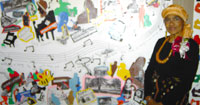
Jazz: Revolutionary
‘music of the spirit’
Published Feb 17, 2006
There was a legend born in the South about meeting the devil at the crossroads. Two well known blues musicians, Tommy Johnson, who wrote “Canned Heat Blues,” and the more famous Robert Johnson, summed up the legend this way: a person comes to a fork in the road and in between the two diverging paths is a man that you hand your instrument to, he will then play a few chords, hand the instrument back to you, and then you’ll be a master.
John Coltrane
John Coltrane
The devil is a mythical creation of religion, but in reality there are evils inherent within capitalist society and the ruling class that exploit workers and the poor, pit workers against one another—all for profit—and give only concessions to appease workers and the poor to stave off a revolution.
Culture is a reflection of human movements and along with resisting racism, poverty and degradation, Black people were also able to create music of clarified beauty. Just as capitalism hastens its own demise, culture mirrors the struggles that continue to develop.
Essentially, the history of slavery, oppression and of the African-American struggle led to the beautiful utterances of “Sorrow Songs” and the blues that led to jazz music. Blacks gained access to instruments and were able to take the same passion expressed in field hollers and the vocal blues tradition to another level with jazz.
Consuela Lee standing next to collage in<br>her honor at Rosa Parks Museum in<br>Montgomery, Ala., Dec. 5, 2005.
Consuela Lee standing next to collage in
her honor at Rosa Parks Museum in
Montgomery, Ala., Dec. 5, 2005.
WW photo: Monica Moorehead
Classical jazz became popular in the early 1900s especially in New Orleans, home to the incomparable Louis Armstrong. How ironic it is that the culture of New Orleans, mostly established by the Black inhabitants, is now being exploited by the local ruling elite to rebuild the city after Hurricane Katrina with out the people that gave New Orleans a big part of its rich culture.
New Orleans was pegged the “Big Easy” because Black musicians found it relatively easy to find music gigs. Many of these musicians were not formally trained, but were able to hone their talent and make a living through their passion for the music.
“Jazz is a music of the spirit. The man’s singing exemplified an undaunted spirit, impeccable intonation and rhythmic perception, as well as improvisational gifts—all essential ingredients for aspiring jazz players to possess,” wrote jazz pianist, composer and member of the Alabama Jazz Hall of Fame, Consuela Lee, about a conversation she had with students after playing a song of an elderly Black man singing during a class on jazz she was teaching. (Workers World, Feb. 22, 2001)
There were so many great jazz artists who were influenced by the Black movements of their eras. Perhaps no other musician has become as symbolic of the times in which he lived than the legendary saxophonist John Coltrane.
When asked about the song he composed, “Ala bama,” and why he named it such, Coltrane responded, “It represents, musically, something that I saw down there translated into music from inside me.” Some refer to the song as melancholy, but its cre scendo at the end, along with rolling drum beats, reflects how deeply the 1963 Birmingham church bombing that murdered four Black girls impacted Coltrane.
“Trane” could hold a note like no other and stretch it to its sinews, and in this he displayed one of his strengths. His defiance in his creations and interpretations demonstrates the resolve of a people.
Jazz more than anything has come to epitomize the resilience and resistance of Black people. As jazz came into its own with improvisation, smashing forms, and existing in a place where one could be free to interpret at a moment’s notice, it was depicting the tenuous nature of living in capitalist North American society of which racism is endemic.
McCoy Tyner, a pianist who played on Coltrane’s seminal album, “A Love Supreme,” summed up what jazz means to Black culture this way: “They want to play the music; we have to play the music.”
Slavery, sharecropping and segregation are the shameful hallmarks of the history of this area. In his book "Twenty-Five Years in the Black Belt," Edward cites: "In the 1920s and 1930s, Black children were allotted 35 cents per child for education while white children received $15 per child."
"Keep 'em ignorant!" is the battle cry of those who control Black Belt schools. I came to the sad conclusion, long before the News articles were printed, that there is a carefully planned death sentence for Black children.
This genocidal policy is sponsored by the state of Alabama, abetted by school administrators and school boards. This policy includes poorly trained teachers, unworkable computers, libraries stocked with books seldom used and months wasted teaching "how to pass" the SATs. There are very few, if any, ongoing music or other arts classes.
This death sentence accelerated with the closing of Snow Hill Institute, a national historic site that had the glorious history of academic achievement plus the indomitable and lasting spirit of a Black man who not only built an educational landmark but brought his people out of the bondage of sharecropping into the independence of landownership.
The state of Alabama, and the corporate timber interests it is subservient to, have kept the Black community in semi-slavery conditions. Reparations must be paid for the crimes committed against the multi-generations of Black people in Alabama's Black Belt.
To read Edwards' "Twenty Five Years in the Black Belt" online, download http://docsouth.unc.edu/edwards /edwards.html

Consuela Lee standing next to collage in
her honor at Rosa Parks Museum in
Montgomery, Ala., Dec. 5, 2005.